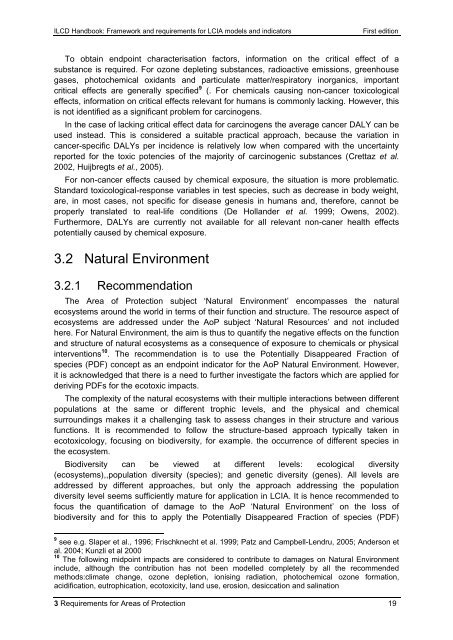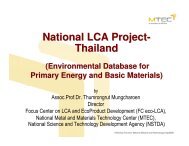ILCD Handbook: Framework and requirements for LCIA models and ...
ILCD Handbook: Framework and requirements for LCIA models and ...
ILCD Handbook: Framework and requirements for LCIA models and ...
Create successful ePaper yourself
Turn your PDF publications into a flip-book with our unique Google optimized e-Paper software.
<strong>ILCD</strong> <strong>H<strong>and</strong>book</strong>: <strong>Framework</strong> <strong>and</strong> <strong>requirements</strong> <strong>for</strong> <strong>LCIA</strong> <strong>models</strong> <strong>and</strong> indicators First edition<br />
To obtain endpoint characterisation factors, in<strong>for</strong>mation on the critical effect of a<br />
substance is required. For ozone depleting substances, radioactive emissions, greenhouse<br />
gases, photochemical oxidants <strong>and</strong> particulate matter/respiratory inorganics, important<br />
critical effects are generally specified 9 (. For chemicals causing non-cancer toxicological<br />
effects, in<strong>for</strong>mation on critical effects relevant <strong>for</strong> humans is commonly lacking. However, this<br />
is not identified as a significant problem <strong>for</strong> carcinogens.<br />
In the case of lacking critical effect data <strong>for</strong> carcinogens the average cancer DALY can be<br />
used instead. This is considered a suitable practical approach, because the variation in<br />
cancer-specific DALYs per incidence is relatively low when compared with the uncertainty<br />
reported <strong>for</strong> the toxic potencies of the majority of carcinogenic substances (Crettaz et al.<br />
2002, Huijbregts et al., 2005).<br />
For non-cancer effects caused by chemical exposure, the situation is more problematic.<br />
St<strong>and</strong>ard toxicological-response variables in test species, such as decrease in body weight,<br />
are, in most cases, not specific <strong>for</strong> disease genesis in humans <strong>and</strong>, there<strong>for</strong>e, cannot be<br />
properly translated to real-life conditions (De Holl<strong>and</strong>er et al. 1999; Owens, 2002).<br />
Furthermore, DALYs are currently not available <strong>for</strong> all relevant non-caner health effects<br />
potentially caused by chemical exposure.<br />
3.2 Natural Environment<br />
3.2.1 Recommendation<br />
The Area of Protection subject ‗Natural Environment‘ encompasses the natural<br />
ecosystems around the world in terms of their function <strong>and</strong> structure. The resource aspect of<br />
ecosystems are addressed under the AoP subject ‗Natural Resources‘ <strong>and</strong> not included<br />
here. For Natural Environment, the aim is thus to quantify the negative effects on the function<br />
<strong>and</strong> structure of natural ecosystems as a consequence of exposure to chemicals or physical<br />
interventions 10 . The recommendation is to use the Potentially Disappeared Fraction of<br />
species (PDF) concept as an endpoint indicator <strong>for</strong> the AoP Natural Environment. However,<br />
it is acknowledged that there is a need to further investigate the factors which are applied <strong>for</strong><br />
deriving PDFs <strong>for</strong> the ecotoxic impacts.<br />
The complexity of the natural ecosystems with their multiple interactions between different<br />
populations at the same or different trophic levels, <strong>and</strong> the physical <strong>and</strong> chemical<br />
surroundings makes it a challenging task to assess changes in their structure <strong>and</strong> various<br />
functions. It is recommended to follow the structure-based approach typically taken in<br />
ecotoxicology, focusing on biodiversity, <strong>for</strong> example. the occurrence of different species in<br />
the ecosystem.<br />
Biodiversity can be viewed at different levels: ecological diversity<br />
(ecosystems),,population diversity (species); <strong>and</strong> genetic diversity (genes). All levels are<br />
addressed by different approaches, but only the approach addressing the population<br />
diversity level seems sufficiently mature <strong>for</strong> application in <strong>LCIA</strong>. It is hence recommended to<br />
focus the quantification of damage to the AoP ‗Natural Environment‘ on the loss of<br />
biodiversity <strong>and</strong> <strong>for</strong> this to apply the Potentially Disappeared Fraction of species (PDF)<br />
9<br />
see e.g. Slaper et al., 1996; Frischknecht et al. 1999; Patz <strong>and</strong> Campbell-Lendru, 2005; Anderson et<br />
al. 2004; Kunzli et al 2000<br />
10<br />
The following midpoint impacts are considered to contribute to damages on Natural Environment<br />
include, although the contribution has not been modelled completely by all the recommended<br />
methods:climate change, ozone depletion, ionising radiation, photochemical ozone <strong>for</strong>mation,<br />
acidification, eutrophication, ecotoxicity, l<strong>and</strong> use, erosion, desiccation <strong>and</strong> salination<br />
3 Requirements <strong>for</strong> Areas of Protection 19



